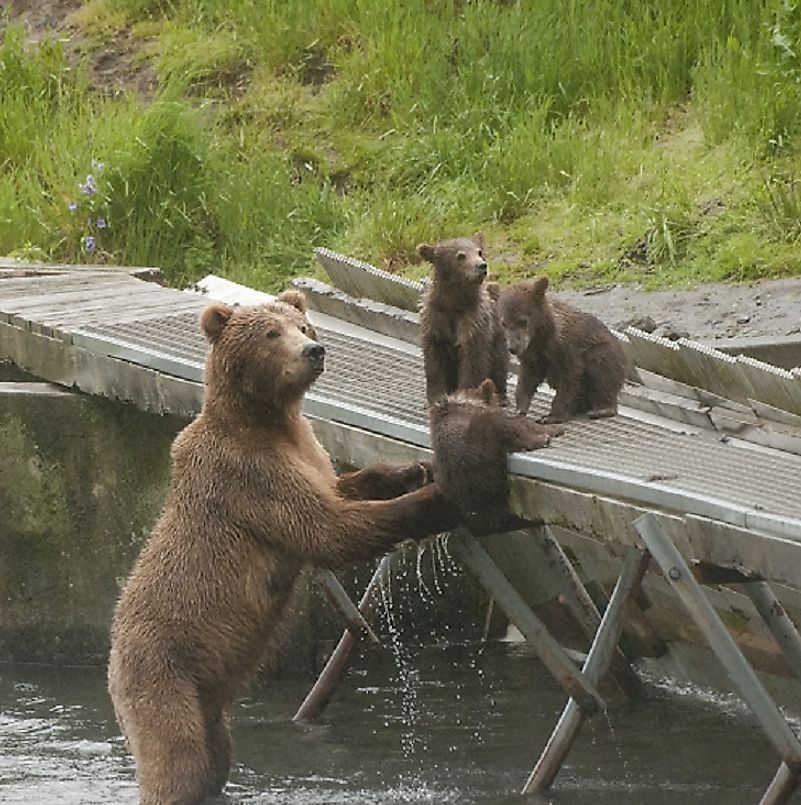Grizzly Bear Facts: Animals of North America

5. Physical Description
The term “grizzly bear” in fact refers to not one, but rather several, species of brown bears which are native to North America, including the Kodiak and California Grizzly. This large animal is a mammal which belongs to the Genus Ursus. They're characterized by their concave faces, long claws (usually measuring two to four inches long), humped shoulders, and distinctive fur. This fur ranges considerably in color, from shades of cream to black. Most often, however, grizzlies are brown, with the hair on their shoulders and back areas having lighter colored tips of white, gold, or grey. Mature grizzly bears weigh approximately 290 to 790 pounds, with males typically being much heavier than females. When standing on their back legs these rugged creatures are usually over six feet tall, while measuring over three feet tall at their shoulders on all fours.
4. Diet
Although Grizzly Bears are members of the Carnivora Order, these animals subsist on a mixed diet consisting of plants as well as animals. They consume various types of plant material, such as grasses, nuts, seeds, roots, and berries. As omnivores, Grizzlies are also known to be skilled and powerful predators. They will prey on animals as diverse in size and shape as deer, buffalo, elk, voles, squirrels, sheep, insects, birds, and fish. Grizzlies can often be found wading into the water during spawning season in order to fish for their beloved salmon. Grizzly bears’ strong and deadly claws play a major role in their ability to catch fish and other animals. Grizzly bears are also known to be scavengers, and will regularly feast on the carcasses of already dead animals.
3. Habitat and Range
Today, the North American Grizzly lives in the western Canadian provinces of British Columbia, Alberta, and northern Quebec, as well as parts of the country’s Northwest Territories. In the U.S., smaller numbers of Grizzlies can be found in states such as Montana, Idaho, Wyoming, and Alaska. It’s estimated that some 25,000 bears make their homes in Canada, while in the U.S. their numbers have been drastically reduced, with the current U.S. Grizzly population thought to number only around 1,500-strong. This animal is officially considered to be a "Threatened" species in the contiguous U.S. Grizzly bears are at risk from various factors related to human activities, including hunting and losses of their habitats due to urban sprawl and other forms of land development. The bears typically spend five to seven months each year in their dens in a state of hibernation. In this way, they are able to weather the cold temperatures of the harsh winters in the far northern reaches of the New World.
2. Behavior
Grizzly bears are solitary animals who don’t travel in packs. They will, however, on occasion gather together at a location where food is abundant, such as a stream teeming with spawning salmon. In order to store up for their hibernation period during the winter, these animals need to bulk up. To do so, they consume a great deal of food during the summer season. The bears use their mighty claws in order to create dens on the sides of hills or cliffs, where they will remain within for the duration of their hibernation periods. Grizzlies are known to be dangerous creatures when coming into contact with humans. This is especially true in a situation in which an unlucky person finds themselves between a protective mother bear and her young cubs.
1. Reproduction
North American Grizzly bears have a significantly low rate of reproduction when compared to other animals. Members of the species aren’t considered to be mature until they're approximately five years of age. Mating occurs during the summer season, before the animal hibernates, and gestation lasts for a total of 180 to 250 days. Females give birth in dens during their hibernation periods, and litters usually consist of one to two cubs per year. Grizzly bear mothers are fiercely protective, and care for their young throughout the first two years of their lives. From the time they’re born until the arrival of warmer summer temperatures, Grizzly bear cubs receive nourishment solely from their mothers' milk, with weaning then commencing.











